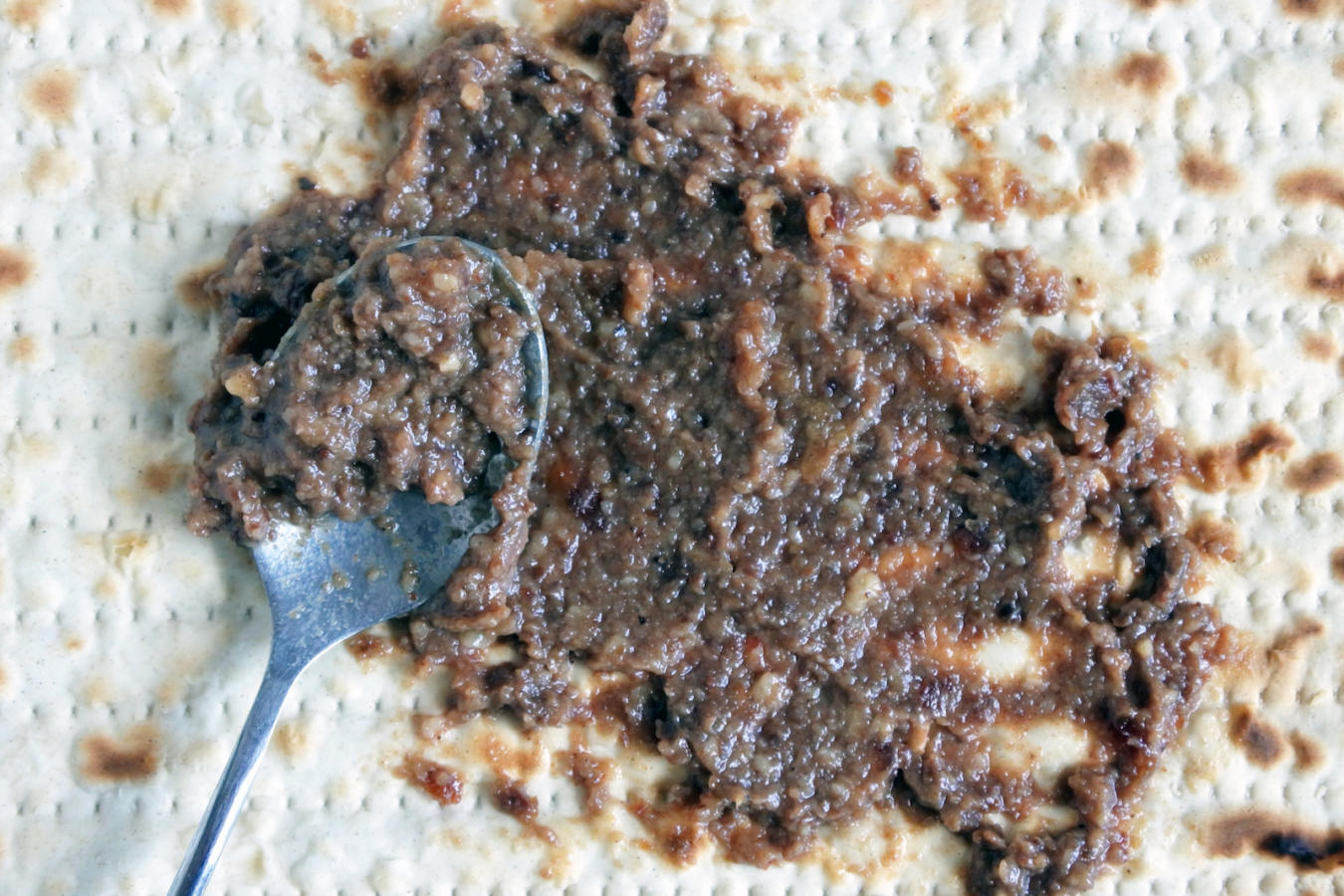In the mysterious culinary language of Passover, each food on the Seder plate embodies a particular meaning.
Traditionally, haroset symbolizes hard labor and oppression. The Talmud Pesachim 116a says the word itself is related to cheres, meaning “clay.” According to Maimonides, haroset symbolizes the mortar that the slaves used to make bricks. He also offers a recipe: “We take dates, dried figs, or raisins and the like, and crush them and add vinegar to them, and mix them with spices, as clay is mixed with straw.” (Hilchot Chameitz uMatzah 7:11).
Yet the ritual meaning of haroset is ambiguous because it is never explained during the Seder. According to the Talmud, one must mention and explain certain foods at the Seder: the paschal offering (symbolized by a bone), the matzah (unleavened bread), and the maror (bitter herb). Haroset is not one of them.
Whether or not the haroset is a Passover obligation – the Talmud records a disagreement on this question — it seems clear that discussing it is not a mandatory part of the ritual. That is, its meaning is not fixed by the Seder, but rather open to interpretation.
With your help, My Jewish Learning can provide endless opportunities for learning, connection and discovery.
This raises the question: Why create such a delicious food to embody such a harsh oppression?
Two legends from the Midrash speak to the role of fruit in the Exodus story and seem to suggest that haroset is not only a symbol of sorrow, but of sweetness.
In Exodus Rabbah 1:12, when the Egyptians seek to kill the male babies of the Hebrews, the Hebrew women save their infants by going out to give birth in the orchards under the apple trees. The babies were then left in the orchards to be cared for by angels. The Midrash says: “God sent an angel from above to cleanse and beautify them, like a midwife who makes the child look beautiful … God then provided for them two nipples, one of oil and one of honey.”
God essentially creates a massive day care center in the orchards of Egypt, with angelic caretakers to watch over the infants. The earth itself becomes nipples to nourish the babies. When the Egyptians find out about this, they try to run plows over the orchards to kill the children, but the children are swallowed up by the earth and saved. Then they grow bigger and proceed in “herds” to their homes, as if they are spring lambs.
The infants in this Midrash, threatened by the cruelty of human beings, find their sustenance directly from the divine. They grow in the orchards as if they are fruit on the Tree of Life. This beautiful Midrash could be connected to the sweet haroset. We eat haroset not only as a reminder of slavery, but as a reminder of redemption and the blossoming spring.
There is yet another story that could connect haroset to redemption. In Exodus Rabbah 21:10, as the people are passing through the Sea of Reeds, the parents of young children have a problem: their children are hungry. It’s easy to imagine how, passing through a split sea at midnight, children would get upset and need a snack. The Midrash says: “The daughters of Israel passed through the sea holding their children with their hands, and when the children cried, they would stretch out their hands and pluck an apple or pomegranate from the sea.”
In this legend, the Sea of Reeds becomes a kind of Eden, producing fruit for those who need it. Again, the miracle of redemption is associated with fruit trees.
When trees blossom and fruit every year, they show us that new growth is possible. Passover offers us much the same message. What if we told the story of the fruit within the sea as part of our Passover Seder and asked one another how the sweetness of the haroset reminds us of the wondrous gifts of liberation and the blessings of springtime? What if the haroset could be not only a symbol of sorrow, but an embodiment of joy? That would seem to match more with joyful experience of eating sweet haroset.
Hiding in the background of all this discussion of orchards is the kabbalistic meaning of orchard. One of the names for Shechinah — the Divine Presence, God’s numinous spirit and God’s bride — is the Holy Apple Orchard. When we eat haroset on Passover, whatever kind of fruit we put in it, perhaps we are making a direct connection with the divine as it dwells on earth. Indeed, in many other cultures, from Greece to Scandinavia to China, the fruit orchard is an otherworldly place, where humans can touch the immortal.
We don’t need, of course, to discard the idea of haroset as mortar. Yet we can complexify and sweeten that meaning by telling some new old stories as part of our Passover story. And we can allow the taste of of the haroset to inspire us to increase the sweetness of liberation in our world.
Rabbi Jill Hammer, PhD, is the director of spiritual education at the Academy for Jewish Religion and the co-founder of the Kohenet Hebrew Priestess Institute. She is the author of a number of books, including “The Jewish Book of Days: A Companion for all Seasons,” “The Hebrew Priestess: Ancient and New Visions of Jewish Women’s Spiritual Leadership” (with Taya Shere), and “The Book of Earth and Other Mysteries.” She lives in New York City with her wife and daughter.



